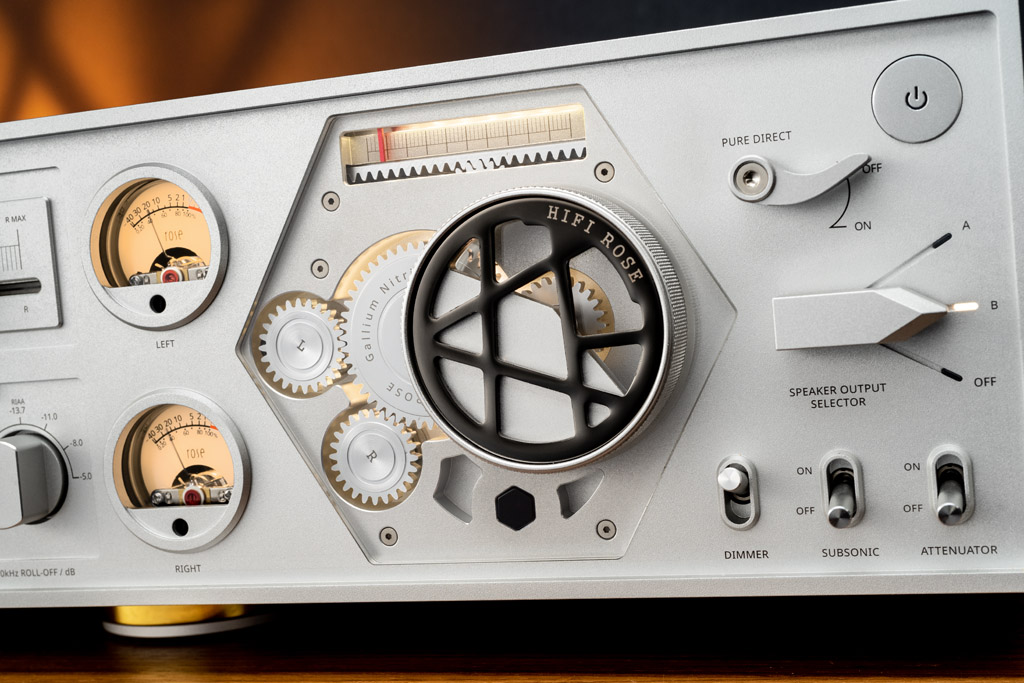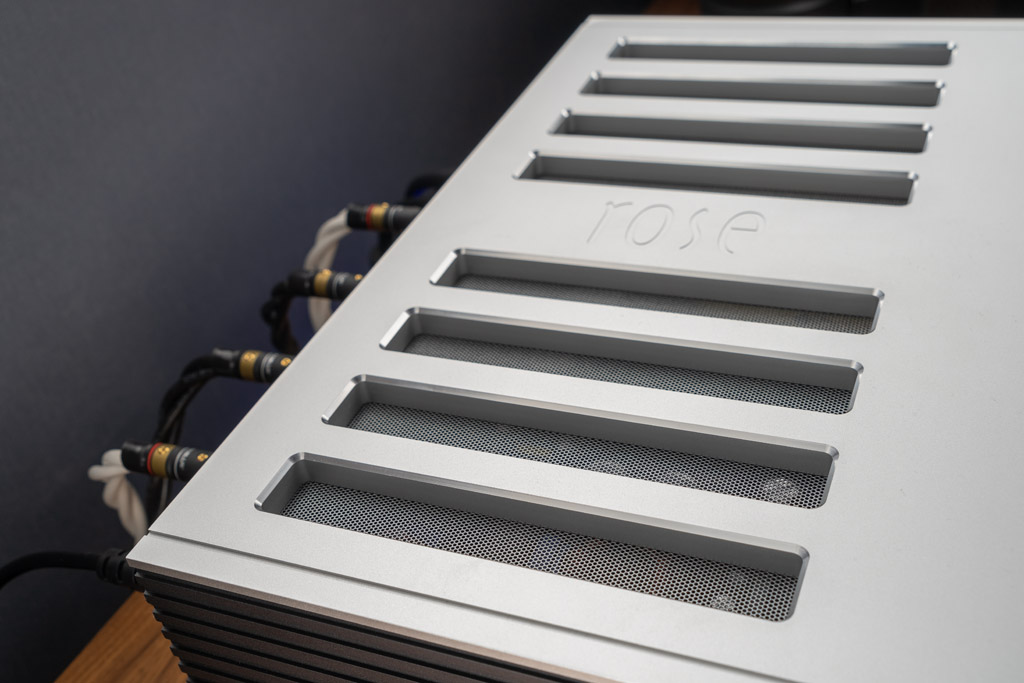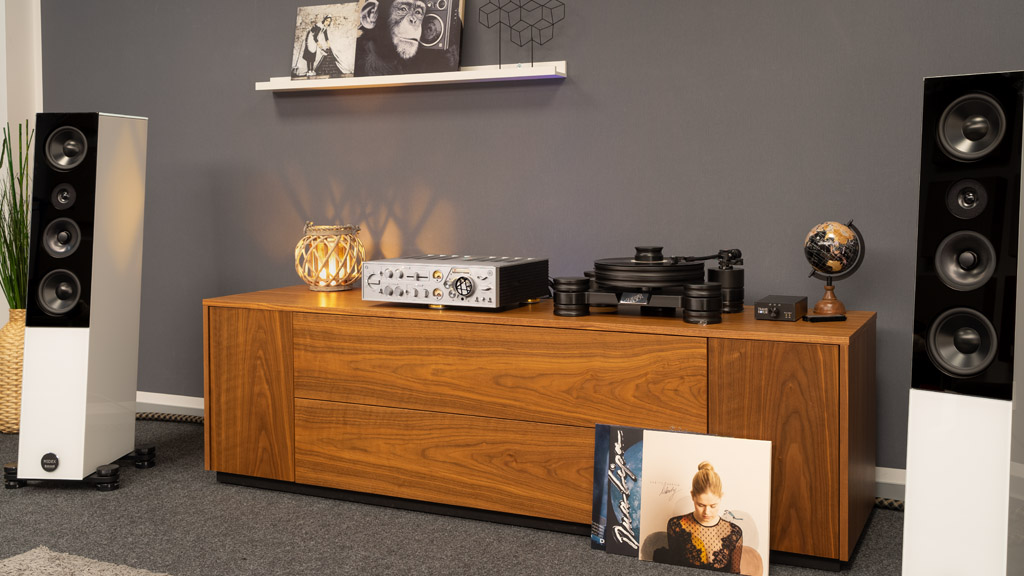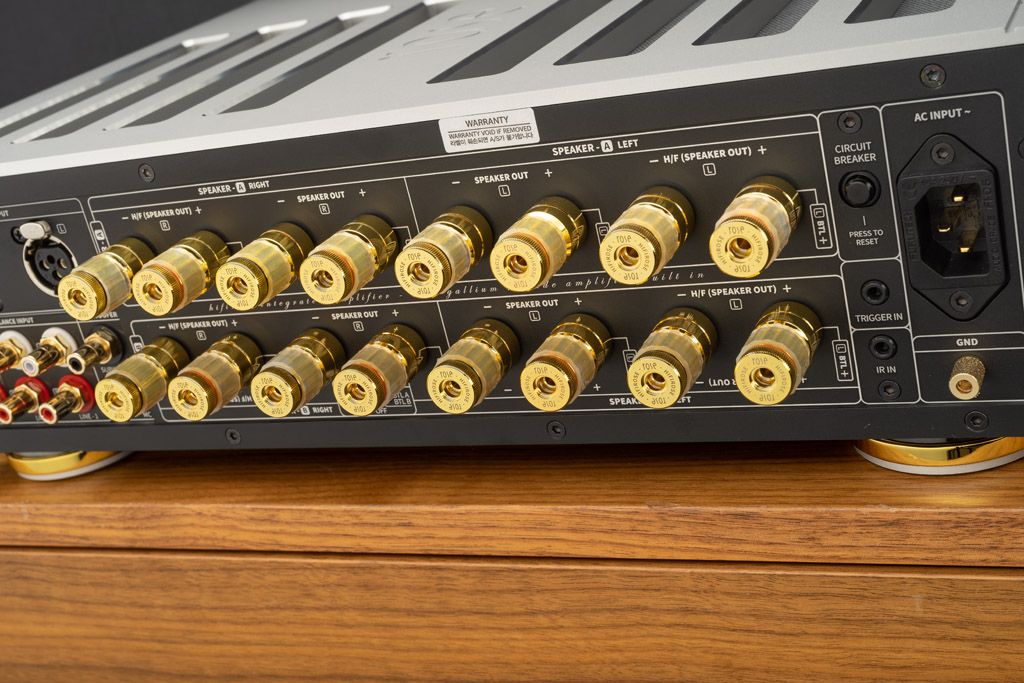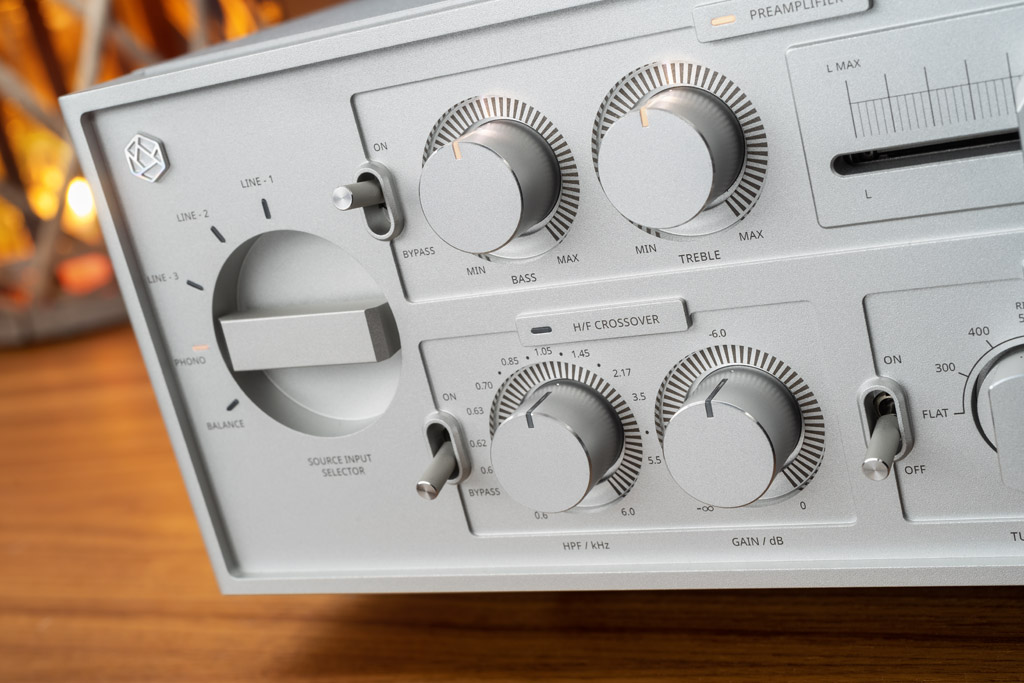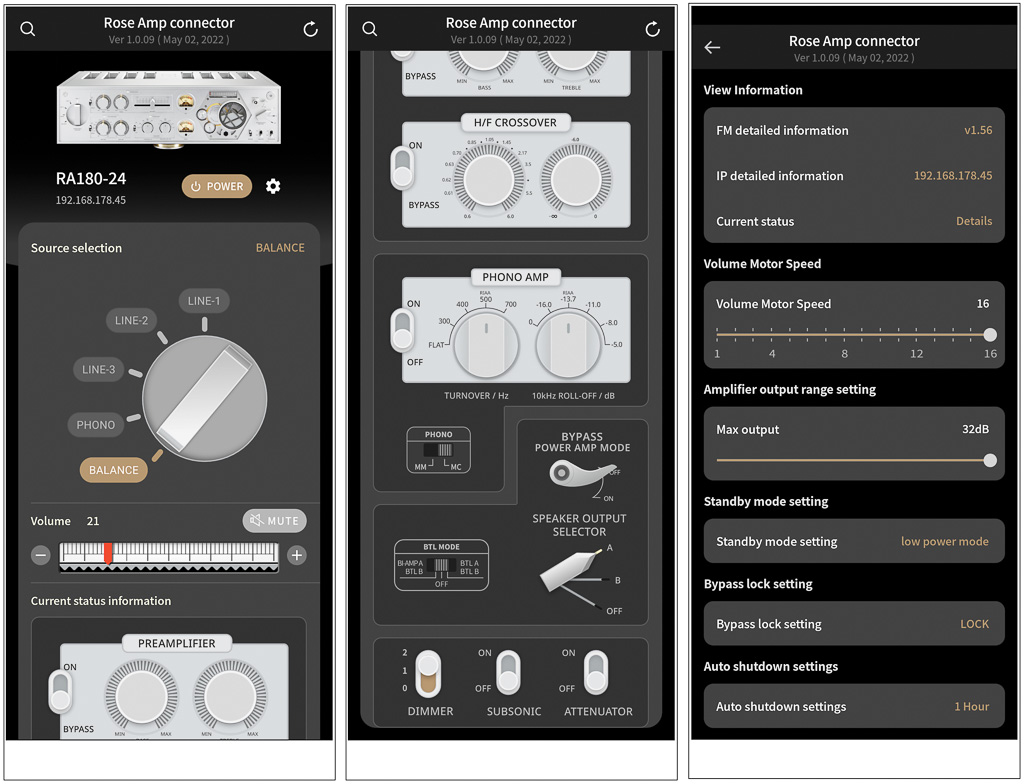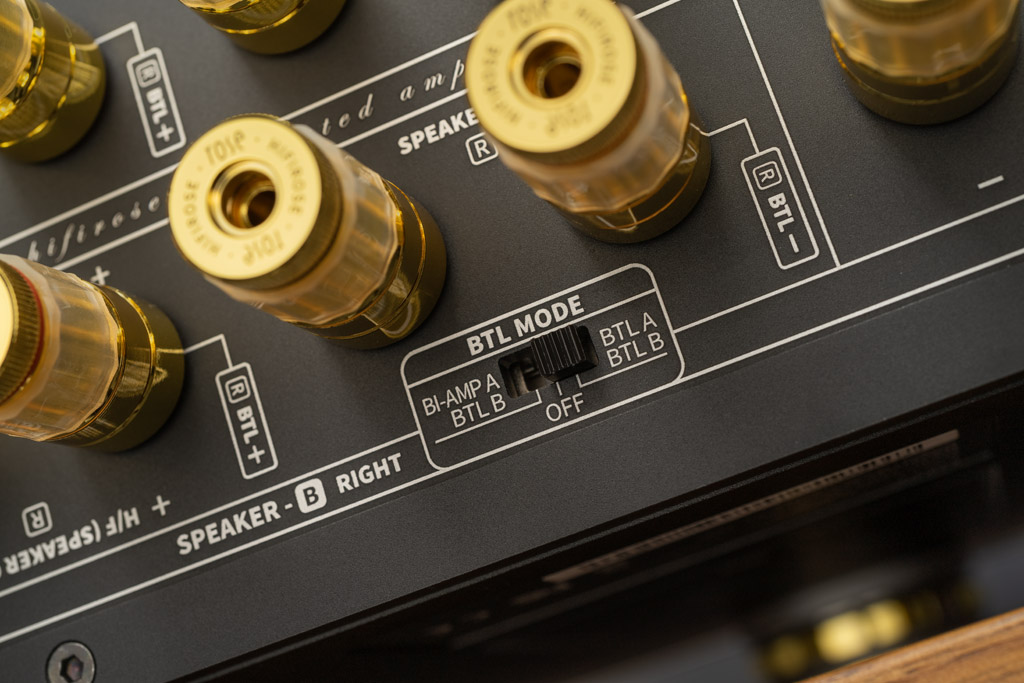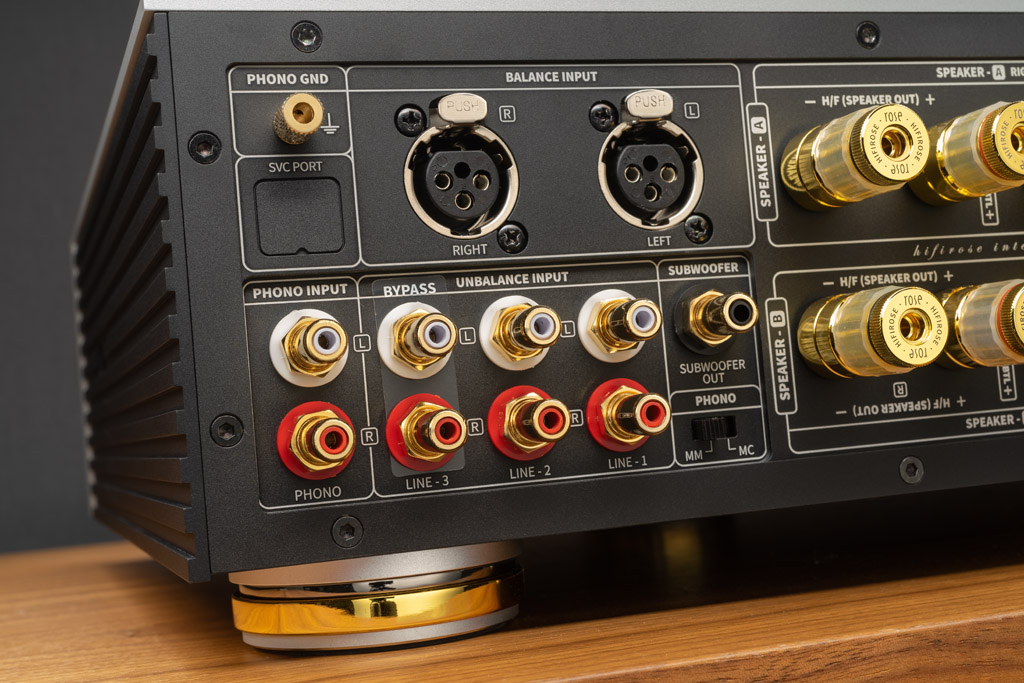TEST: Rose RA180 - High-tech integrated amplifier in steampunk design
by Philipp snailburger
editor-in-chief
ENGLISH
Open your eyes and prick up your ears! With the RA180, Rose once again combines eye-catching design with good sound. Instead of huge touchscreens, the luxury brand relies on the appeal of the mechanics for their new amplifier, garnished with the latest technology. The practical test will show whether the stylish powerhouse also has the necessary substance.
Restraint isn’t the RA180’s thing. It is a device to be admired and touched.
My fingertips touch corrugated aluminum. Thumb and forefinger seek support with light pressure before a gentle twist of the wrist sets off a chain reaction. The letters HiFi Rose move clockwise with the movement of my hand. Metallic teeth interlock, exert pressure, push. A red line moves slowly and evenly across a narrow scale. At the same time, I feel delicate vibrations in my fingers when a tooth loses contact with its counterpart, while its neighbors melt together again at the same moment. A few centimeters further, thin hands react to what is happening. Initially swaying slightly from left to right and back, their movements gradually turn into ecstatic wriggling. At the end of the journey I untie my hand,
With all your senses
This is an experience that owners of an RA180 can look forward to every time they turn up the volume. It’s a spectacle like no other and likely won’t find it anywhere. Rose, the Koranic manufacturer whose philosophy is to fuse the beauty of music and devices, has created a new exceptional product. While the company’s music serversrely on huge touchscreens and thus draw attention to themselves, the RA180 takes the opposite route. Gone are the days of minimalism, where buttons and knobs are a thing of the past. The integrated amplifier relies on mechanics, levers and gears. And yet both the server and the amplifier are devices to behold and touch. This is about more than sound. Man and machine are practically forced into direct contact. Showing, seeing, touching, experiencing and ultimately, of course, hearing.
The volume control with gear conversion and mechanical horizontal scale is the highlight of the front. If you use the remote control, the large controller moves to its new position with a soft whirring noise.
material battle
A lot of earth had to be moved and a lot of ore melted so that this meeting of the senses also met the demands of creator and user. The RA180 weighs almost 17 kilograms, although it consists almost exclusively of supposedly light aluminum. But with material thicknesses of over ten millimeters, a lot comes together. Of course, this also applies to the number that lights up on the cash register when you hand it over. For that you get a lot of metal that is beautifully shaped and staged in a classy way. I usually appreciate it when a single button on a hi-fi device feels mechanical. The RA180 takes this to the extreme. Here a number of switches, levers and buttons want to be flipped, turned or pressed. No input remains without a reaction from the amplifier. Be it through clicking, glowing and of course the sound effects: every touch is conscious and necessary.
The enormous thickness of the material can be clearly seen from the cooling openings on the top. Thanks to the slots, the RA180 does not get overly hot during operation.
elemental
Eighteen different controls are located on the front panel of the amplifier. Not all of these are needed all the time, but it clearly shows what possibilities the RA180 wants to offer its user. Port selection, volume control, tone adjustment, bypass modes - all combined in the front panel control center. Before picking an album, it almost feels like a pre-flight check on an airplane. If you are looking for something special, you are on the right track here. It is all the more astonishing that Rose, despite all the gears and levers, relies on the latest technology. Not only that, they have even developed completely new technologies themselves. The developers are talking about an amplifier with a class AD circuit. The efficiency of Class-D should be combined with the linearity of Class A/AB.
Visually, the advanced technology of the amplifier cannot be seen. The 400 watts of the new transistors have an easy job even with large floorstanding speakers.
At the crossroads
In addition to the technical refinements of the amplifier, the performance development is also remarkable. Loudspeakers driven by the RA180 each receive up to 400 watts, regardless of whether they are at four or eight ohms of impedance. But how many sound transducers you want to drive, or how this is done, requires some consideration. As busy as it gets here on the front of the amp, things continue on the back. Lots of terminals are waiting there for wires, cable lugs and banana plugs. Two different pairs of speakers can be connected here at the same time and selected with one of the controls on the front. The operation of both pairs at the same time is not possible. The RA180 is designed not only for bi-wiring, but even for bi-amping. Each set of outputs offers separate terminals for the separate operation of tweeter sections. In this case, the four available output stages of the amplifier then each deliver 200 watts per output.
The back offers four sets of gold-plated terminals. These are separated into A and B, and high and low tones.
At the top
The crossover frequency and gain can be adjusted in bi-amping mode to match the speakers and tweeters of your choice. Two of the front knobs are turned off for exactly that. The tools are activated by flipping a switch, whereupon a luminous stripe on the potentiometers and a beam of light on the surrounding scales clarify the set values. Rose placed special emphasis on the high-frequency reproduction of the RA180. Accordingly, people were not satisfied with the usual frequency range of 20 hertz to 20 kilohertz. Compatible “super tweeters”, i.e. particularly powerful tweeters, are supplied with frequencies of up to 100 kilohertz. While that’s well outside the human hearing spectrum, it doesn’t mean it doesn’t affect playback.
Next to the large source knob are the tone control options. The bi-wiring adjustment and the general sound adjustment can be set separately.
Custom work also for vinyl
Another pair of rotary controls, including its own on/off switch and illuminated display, is then provided for the internal tone control of the amplifier. Up to 15 decibels in both directions, the high and low frequencies can be adjusted to your own requirements. The detailed instructions even show the resulting frequency responses. For adjusting the balance between left and right, the RA180 then offers a slightly less spectacular slider. The amplifier can also be switched to subsonic mode with another lever. If this is activated, the bass reproduction drops steeply below 80 Hertz. In this way turntables in particular are to be protected from the influence of vibrations. MM and MC systems can even be connected directly to the Rose’s phono input, of course combined with numerous customization options. Depending on the recording, low-band turnover and high-band roll-off can be adjusted separately. This is done, how could it be otherwise, with two controls on the front.
The integrated phono module of the amplifier can be used with MM and MC systems. In addition, the roll-off values can be adjusted depending on the record label.
finger pointing
Rose shows again that they succeed in merging old and new audio worlds. The weakness for old vinyl recordings from a wide variety of labels is countered by the network capability of the RA180. However, this has nothing to do with playback, because the amplifier is a purely analog device that has no digital connections. The WLAN connection is used here exclusively to establish the connection with the Rose Amp Connect app. The free application allows you to select the source and volume using your smartphone. Finger tapping on the screen is then followed by the mechanical work of servomotors, which then move the corresponding rotary control on the device to the selected position. Sound controls and the like, on the other hand, can only be controlled in the app, not changed. Setting up the WLAN connection and the first pairing with the smartphone did not go completely without problems either. Accordingly, the RA180 also comes with a classic remote control.
The free app is nicely made and a nice addition to the remote control. However, it can only be used for certain functions and lacks a bit of precision.
circuit diagram
The app can therefore be understood more as a nice bonus and entertaining gimmick. And the best user experience is simply to operate the RA180 with your own hands, directly on the device. So output A of the amplifier is equipped with cables, at the other ends of which a pair of floorstanding loudspeakers are connected. Due to the many connections, you should definitely take a look at the instructions before wiring. For a pair of speakers and single-wiring operation, the corresponding connections are marked separately, but better safe than sorry. Then set the small switch on the back to the appropriate mode and connect the source devices of your choice via XLR or cinch. I decide on a HiRes music server to take a closer look at the upper frequency range with the right material.
Rose RA180 - Mechanical optics with natural sound
The smooth oboe tones float gently out of the loudspeaker towards the listening position. The amplifier draws numerous details from the signal, which it combines to create an incredibly complex, multi-faceted sound. The accompanying harpsichord is convincingly direct. The characteristic “squeaking” seems extremely real and plastic. The dynamic attack of the strings is followed by their fine fading away, in which every vibration is completely drawn through. Despite the high pitches, the rose does not develop any sharpness or unpleasant peaks. The arrangement remains clean and flowing. The music glides along like a brush on a canvas and paints a pleasantly harmonious picture. The timbres, to stay with the metaphor, are also convincing. Not unnaturally cold and not oppressively warm.
The operating mode is set with the small slide switch. When connecting a single pair of speakers and single wiring, it is set to the right position. For the wiring, however, a look at the instructions is essential.
Pack up
Accordingly, the glass gears that control the individual potentiometers for the right and left channel can start moving again. In combination with the connected Audio Physic Midex, I even have to be a little careful. The powerful gallium nitride FETs push hard and the setup already develops advanced volumes in the lower range of the scale. So there is by no means a lack of power, but as is well known, it is nothing without control. It’s a good thing that the RA180 isn’t guilty of anything either. With the agile, hectic “Boomerang” of the Tingvall Trio, he always has the membranes under control. The good response behavior leads to great dynamics, every time the sticks hit the skins and cymbals of the drums, or the keyboard is played courageously.
With power
The RA180 also knows how to please when it comes to stage performance. This is projected pleasantly centrally into the room by the amplifier and flooded with the dust-dry, diffuse bass tone of the double bass during “Carousels”. The HiRes recording provides a lot of details, all of which the Rose takes with it. Even the slight creaking when gripping the instrument remains audible here. Of course, recordings in CD quality don’t quite keep up. But even in the endurance test with “Through The Fire And Flames” the amplifier showed no weaknesses. Even with the heaviest guitar shredding, the Dragonforce song seems pleasingly differentiated and defined, even if the plasticity decreases a bit due to the abundance of elements. In return, the good transparency is maintained. Cymbals, bass and keyboards don’t go under in the storm of the two super-fast guitars. Undeterred, the RA180 does what it is told to do. He is a real workhorse who doesn’t seem too bad for anything.
The RA180 ensures sufficient connection variety. In addition to the phono input, there are three more cinch inputs, supplemented by a pair of XLR sockets. If you want, you can also connect a subwoofer.
Conclusion
The Rose RA180 is exceptional in every way. Its design is unique, its technology is innovative and its sound is outstanding. With four powerful power amplifiers, the integrated amplifier drives practically every speaker effortlessly while maintaining control at all times. You may dismiss its optical features and the many setting options as a gimmick, but the amplifier takes its work seriously when it comes to sound. No matter which genre you prefer, he always seems to get everything out of the signal. He doesn’t want to put his stamp on the music, but simply offer great, musical and natural sound. With the RA180, Rose simply offers an experience for the eyes and ears.
Test & Text: Philipp Spiral Burger
Photos: Philipp Thielen






